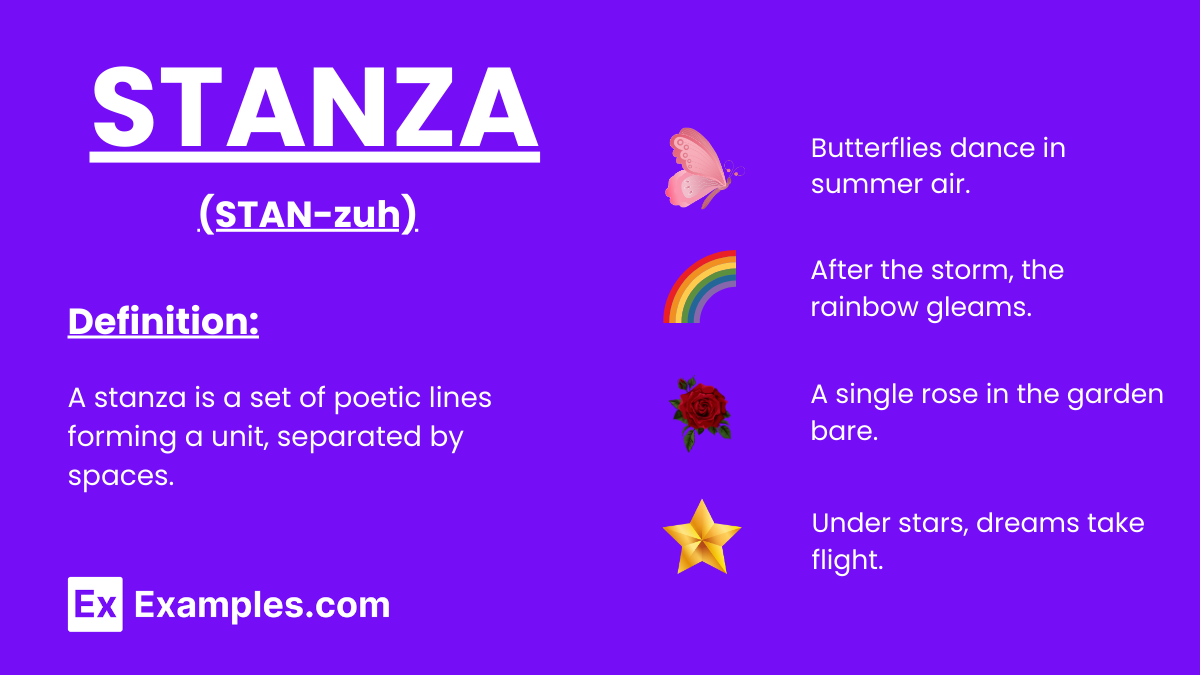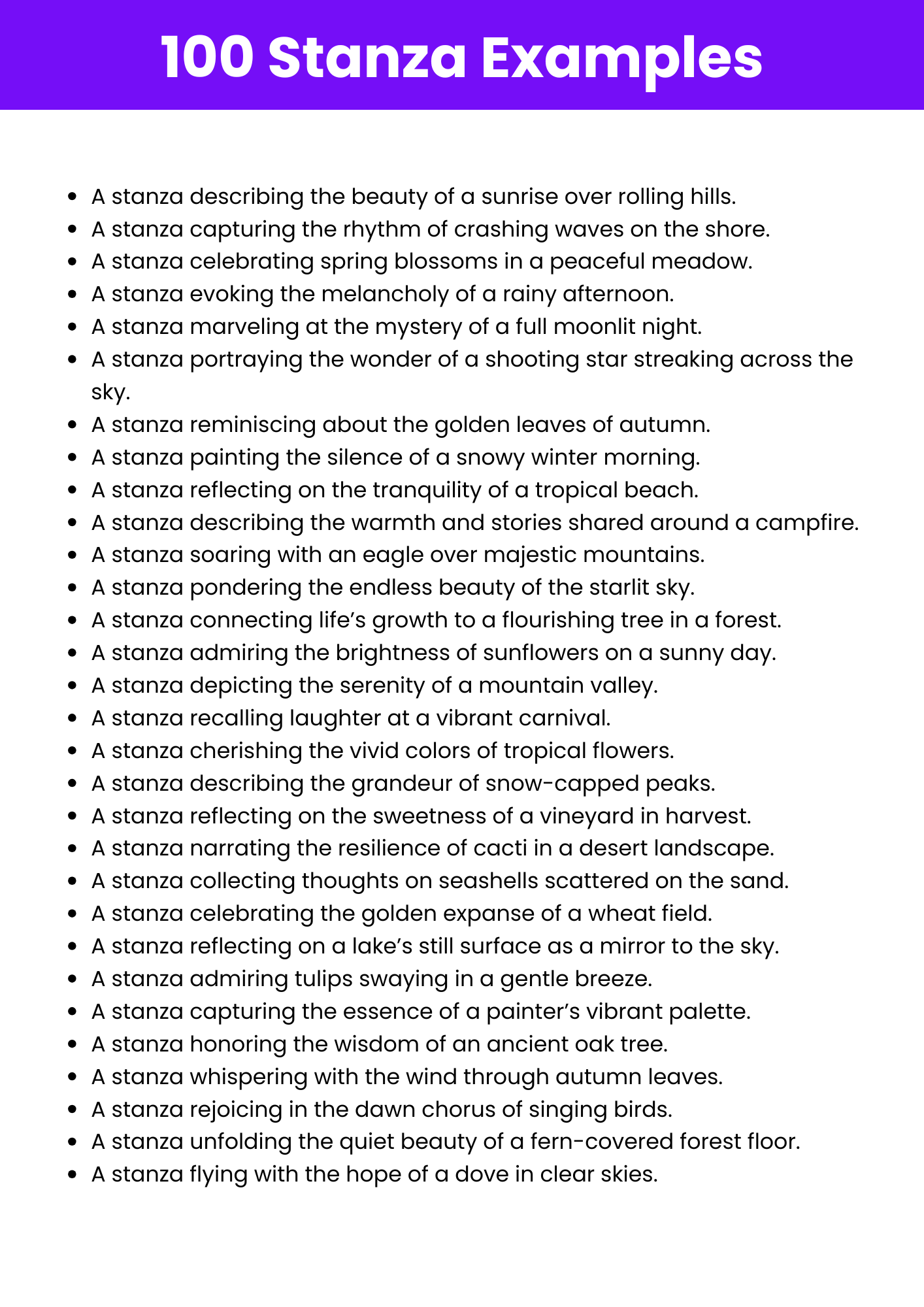Stanza
What is Stanza? – Definition
A stanza is a grouped set of lines in a poem, often forming a unit with a specific pattern, rhyme, or theme, used to organize and convey meaning or emotion.

Generated Stanza Examples

Examples of Stanzas
- A four-line quatrain describing a peaceful meadow.
- A romantic stanza praising the beauty of love.
- A stanza capturing the stillness of the night sky.
- A stanza from a song about finding hope in adversity.
- A stanza portraying the sound and rhythm of ocean waves.
- A stanza evoking the colors and feel of autumn.
- A stanza about freedom, with imagery of birds in flight.
- A stanza depicting the majesty of a snow-covered mountain.
- A nostalgic stanza reminiscing about childhood memories.
- A stanza expressing the fiery passion of a rebellious spirit.
- A stanza dedicated to dreams and aspirations.
- A melancholic stanza reflecting on a rainy day.
- A stanza celebrating the renewal brought by spring.
- A stanza describing the energy of a city at night.
- A stanza focusing on the bond between family members.
- A cosmic stanza exploring the mysteries of the universe.
- A stanza conveying the pain of a broken heart.
- A stanza that captures the colors of a vibrant sunrise.
- A stanza that paints a warm picture of home.
- A dramatic stanza revealing the struggles of human emotions.
- A sorrowful stanza mourning a lost love.
- A rustic stanza inspired by life in the countryside.
- A stanza marveling at the vastness of the Milky Way.
- A stanza depicting the serenity of a quiet bridge at dusk.
- A stanza full of energy, describing a volcanic eruption.
- A nostalgic stanza recalling childhood fun at a carnival.
- A stanza reflecting on the wisdom contained in old books.
- A stanza about adventure, with imagery of maps and compasses.
- A reflective stanza pondering the flicker of a lone candle.
- A stanza inspired by the colors and emotions in a painting.
Types of Stanzas
Couplet
A stanza consisting of two lines, often rhyming.
- A love poem closing with a rhyming couplet.
- A witty couplet summarizing a moral lesson.
- A couplet describing a serene sunset.
- An inspirational couplet at the end of a speech.
- A humorous couplet in a satirical poem.
Tercet
A stanza composed of three lines, often with a rhythmic pattern.
- A tercet describing a quiet forest in autumn.
- A reflective tercet about the cycle of life.
- A tercet highlighting the power of imagination.
- A tercet capturing the vastness of the desert.
- A tercet exploring the complexity of emotions.
Quatrain
A stanza of four lines, often with alternate rhymes.
- A quatrain celebrating the beauty of spring.
- A quatrain reflecting on a walk in nature.
- A dramatic quatrain about a sudden storm.
- A quatrain used as a moral lesson in a fable.
- A quatrain about the wonder of the night sky.
Sestet
A stanza with six lines, often used in sonnets.
- A sestet resolving a conflict in a narrative poem.
- A sestet painting a vivid picture of a rural scene.
- A sestet expressing tranquility and peace.
- A sestet dedicated to the theme of love.
- A sestet summarizing the key message of a poem.
Octave
A stanza containing eight lines, often used to set up a problem or idea.
- An octave introducing a mystery in a narrative poem.
- An octave describing the intricacies of human nature.
- An octave reflecting on the passage of time.
- An octave capturing the beauty of a sunrise.
- An octave exploring the balance of nature.
Free Verse
Stanzas without a specific rhyme or rhythmic pattern.
- A free verse stanza describing a bustling city.
- A free verse stanza capturing a moment of joy.
- A free verse stanza exploring the depths of thought.
- A free verse stanza portraying the vastness of the sea.
- A free verse stanza recounting a powerful storm.
How to Identify and Understand Stanzas?
Identifying stanzas involves recognizing groups of lines in a poem that form a distinct unit, often separated by spaces and structured with rhyme or rhythm.
- Look for clusters of lines separated by spaces in a poem.
- Note the consistent patterns of rhyme or rhythm in the lines.
- Identify the themes or ideas each stanza presents within the poem.
- Observe changes in tone, subject, or imagery between stanzas.
- Understand how stanzas contribute to the poem’s overall structure and meaning.
How to Use Stanzas?
Using stanzas effectively involves structuring your poem to organize thoughts, enhance rhythm, and create emotional impact.
- Group related lines into stanzas to convey specific ideas or themes.
- Use stanza breaks to create pauses and emphasize transitions in the poem.
- Experiment with different stanza lengths to influence the poem’s rhythm and flow.
- Incorporate rhymes or repetitive structures to enhance the musicality of stanzas.
- Use stanzas to evoke emotions and guide the reader’s interpretation of the poem.
Other Examples of Stanzas
Narrative Stanza
Stanzas used to tell a story or recount events.
- A stanza narrating a hero’s journey through unknown lands.
- A stanza describing a fateful meeting at a crossroads.
- A stanza recounting the discovery of a hidden treasure.
- A stanza set on a journey aboard a mysterious train.
- A stanza chronicling a king’s decision to go to war.
Descriptive Stanza
Stanzas that focus on vivid imagery or sensory details.
- A stanza painting the beauty of a sunrise over the mountains.
- A stanza describing a meadow in full bloom.
- A stanza capturing the roar of ocean waves crashing against the shore.
- A stanza detailing the tranquility of a dense forest.
- A stanza depicting storm clouds gathering over a quiet town.
Reflective Stanza
Stanzas that delve into thoughts, emotions, or philosophical ideas.
- A stanza pondering the fleeting nature of time.
- A stanza reflecting on the complexity of human emotions.
- A stanza questioning the meaning of existence.
- A stanza celebrating the power of hope and resilience.
- A stanza meditating on the beauty of silence.
Lyric Stanza
Stanzas that express personal emotions or feelings, often in a musical style.
- A stanza expressing the joy of reunion after years apart.
- A stanza mourning a lost love with heartfelt emotion.
- A stanza evoking melancholy during a rainy afternoon.
- A stanza celebrating the peace found in solitude.
- A stanza capturing the excitement of newfound inspiration.
Romantic Stanza
Stanzas that explore themes of love and beauty in an imaginative style.
- A stanza describing the first blush of love in spring.
- A stanza celebrating the timeless beauty of a red rose.
- A stanza depicting a starlit night shared by lovers.
- A stanza capturing the romance of a walk along the shore.
- A stanza reflecting on love’s bittersweet nature.
Epic Stanza
Stanzas that recount heroic tales or grand adventures.
- A stanza narrating a warrior’s triumph in battle.
- A stanza chronicling an explorer’s journey across the seas.
- A stanza capturing the awe of venturing into space.
- A stanza describing a mythical quest through enchanted woods.
- A stanza depicting the trials of crossing a vast desert.
Explore Other Literary Devices
Elevate Your AP English Preparation
Unlock your potential with our comprehensive AP English exam preparation tools designed to help you excel.
- Extensive Question Bank: Access 900+ exam-like questions for both AP English Language and Literature.
- Expertly Crafted: Questions mirror the structure and difficulty of actual AP exams, ensuring relevant practice.
- Detailed Explanations: Understand your mistakes with clear, concise breakdowns of correct and incorrect answers.
- Personalized Learning: Tailor your study sessions with topic-specific tests and adaptive learning tools.
- Comprehensive Coverage: Master all aspects of the AP English curriculum with extensive guides and resources.
Frequently Asked Questions
-
What is a stanza?
A stanza is a grouped set of lines in a poem, often separated by a space, serving as a unit of thought or structure. -
How many lines are in a stanza?
Stanzas can vary in length, commonly containing 2, 3, 4, or more lines, depending on the poet’s style and structure. -
What is the purpose of a stanza in poetry?
Stanzas organize a poem’s thoughts, themes, or emotions, often providing rhythm, structure, and visual breaks. -
What are common types of stanzas?
Common types include couplets (2 lines), tercets (3 lines), quatrains (4 lines), and octaves (8 lines), among others. -
How does a stanza differ from a verse?
A stanza is a structured group of lines in a poem, while a verse refers to a single line or a poetic composition as a whole. -
Can a stanza have a rhyme scheme?
Yes, stanzas often follow a specific rhyme scheme, such as ABAB or AABB, but can also be free verse with no rhyme. -
How are stanzas used in modern poetry?
Modern poetry uses stanzas flexibly, often breaking traditional forms to create unique rhythms and expressions. -
Are stanzas always of equal length?
No, stanzas can vary in length throughout a poem, depending on the poet’s intent and the flow of the narrative or emotion. -
What role do stanzas play in conveying emotion?
Stanzas help emphasize emotions by grouping related ideas and providing pauses that enhance the poem’s rhythm and impact. -
Can stanzas be used in song lyrics?
Yes, stanzas are commonly used in song lyrics, often referred to as verses, to structure the lyrics and convey the song’s message.

